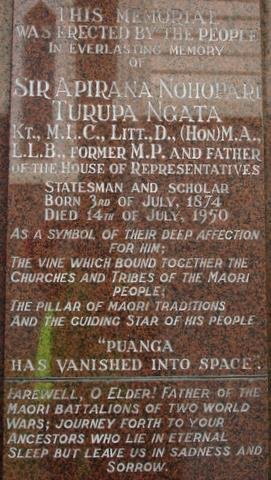![]()
East Cape, 2009
Te Araroa to Tokomaru Bay4 November, 2009
Time now to start heading south.
This was the day we encountered some of the strongest winds on the whole tour.
And some good hills, too.
The St Mary's Church, Tikitiki.
Altar Window
Photo: John McKThe Church, built in 1924, is a living memorial to the soldiers of Ngati Porou who fought in
both WW I and WWII.
Memorial to Sir Apirana Ngata.

Photo: John McK
Apirana Ngata (1874–1950), of Ngati Porou, was born at Te Araroa on the East Coast. He graduated from Te Aute College, and later completed an MA and a law degree. He was the first Maori to complete a degree at a New Zealand University. He returned to the East Coast and became involved in improving Maori social and economic conditions.
Unlike a number of other tribes, Ngati Porou had kept much of their land. The young Ngata, armed with legal expertise and determined to achieve progressive farming techniques and land tenure reform, encouraged sheep farming and investment in land development.
By 1916 Ngati Porou were running more than 180,000 sheep. Ngata favoured the incorporation of owners into more workable legal bodies. It was a way to retain tribal ownership and to efficiently use land with multiple owners. It also meant fragmented Maori land titles could be combined into viable farming units.
During this early period Ngata was also prominent in the Young Maori Party. This movement was crucial in changing the focus of the Kotahitanga movement from the Treaty of Waitangi and Maori political autonomy, to pursuing its aims through mainstream politics.
In 1905 Ngata was elected to Parliament representing Eastern Maori. He was to retain the seat until 1943. He was a superb debater and a hard worker.
He first came to national prominence in connection with the 1907 Commission on Native Lands and Native Land Tenure. This was set up because of concern at the scale of European land purchase in the early twentieth century. The Commission was presided over by Robert Stout and Ngata. Its main task was to devise ways of utilising Maori land in a way to benefit both Maori and European settlers. The Stout-Ngata Commission, as it came to be called, was sympathetic to Maori, whom it described as a people "starving in the midst of plenty". It recommended that Maori retain large tracts of their remaining lands, and that the state should give farming assistance and training. But these recommendations were not followed and little was done. Instead, land purchase increased significantly in the following two decades.
Ngata also helped the jurist John Salmond draft the Native Land Act 1909, a massive statute that consolidated all previous Maori land law.
During the First World War Ngata maintained a Ngati Porou tradition of loyalty to the Crown, and recruited Maori servicemen. He later built on the respect Maori servicemen had won during the war, achieving inquiries into many long-standing land grievances. Among them was the Sim Commission, which investigated land confiscations after the wars of the 1860s and upheld many grievances, despite limited terms of reference.
In 1927 Ngata received a knighthood, and in the following year became Native Minister in the United government. He was now able to press ahead with state-funded Maori land development, and set up land development schemes all over the country. His wider aim was to strengthen Maori communities and revive Maori culture.
Much of his success came from working through traditional tribal structures. In his land development work Ngata also encouraged a revival in Maori art and cultural studies. He helped set up a Maori school of arts at Rotorua, the Board of Maori Ethnological Research, and the Maori Purposes Fund Board.
Most Europeans had little sympathy for Maori land development, especially at a time of deepening depression and cutbacks in other government spending. Because of historical land loss much Maori land being developed was poor or marginal. Some schemes failed, adding to the resentment. Ngata, impatient with "red tape", tended to make decisions on the run, and Native Department officials were often unable to keep up with the paperwork. By the beginning of 1932 there was increasing criticism of Ngata. Irregularities were found in a number of accounts, and a Committee of Inquiry was set up. Its 1934 report criticised many aspects of Ngata's administration, and he immediately resigned as Minister. He was defeated by the Labour/Ratana candidate in the 1943 election. Ngata's development schemes remained a key element of Labour's Maori land policy, however, and many continued until the 1970s and 1980s.
Ngata died in 1950. He made an immense contribution to the Maori cultural and economic revival in the first half of the twentieth century.
(Notes from www.nzhistory.net.nz.)
Morning tea at Tikitiki.
A minor problem - made you feel sheepish worrying about it.
Photo: Maurice
The dogs kindly cleared the sheep off the road so we could get through.
Ruatoria Art.
Photo: Maurice
Ruatoria Pub
Photo: Maurice
We chose not to go to the edge - we were cyclists and did not want to fall off.
Photo: Maurice
Typical East Coast scene.
Typical ACTA scene on a warm afternoon.
The wharf at Tokomaru Bay.
Brown's Cows heading for dinner.
Photo: John McK
The last stragglers approach the Tokomaru Bay Tavern.
Photo: John G
And that's where they serve up man-sized meals like this
feed of fish, chips 'n salad.
Photo: John G
Southern end of Tokomaru Bay.
Photos: Margaret L, except those that aren't.
Want to tell the Webmaster something?